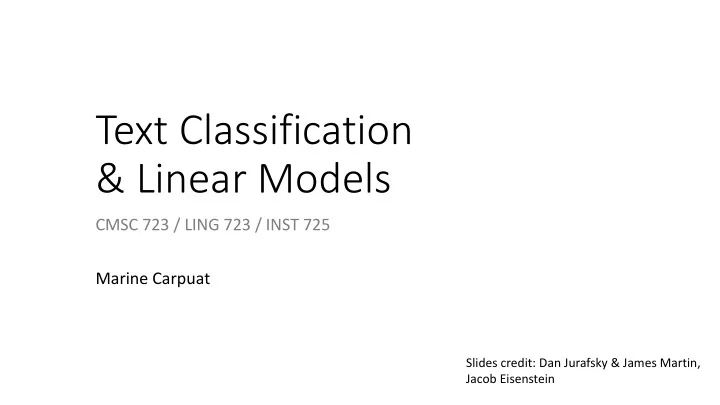

Text Classification & Linear Models CMSC 723 / LING 723 / INST 725 Marine Carpuat Slides credit: Dan Jurafsky & James Martin, Jacob Eisenstein
Logistics/Reminders • Homework 1 – due Thursday Sep 7 by 12pm. • Project 1 coming up • Thursday lecture time: project set-up office hour in CSIC 1121
Recap: Word Meaning 2 core issues from an NLP perspective • Semantic similarity : given two words, how similar are they in meaning? • Key concepts: vector semantics, PPMI and its variants, cosine similarity • Word sense disambiguation : given a word that has more than one meaning, which one is used in a specific context? • Key concepts: word sense, WordNet and sense inventories, unsupervised disambiguation (Lesk), supervised disambiguation
Today • Text classification problems • and their evaluation • Linear classifiers • Features & Weights • Bag of words • Naïve Bayes
Text classification
Is this spam? From: "Fabian Starr“ <Patrick_Freeman@pamietaniepeerelu.pl> Subject: Hey! Sofware for the funny prices! Get the great discounts on popular software today for PC and Macintosh http://iiled.org/Cj4Lmx 70-90% Discounts from retail price!!! All sofware is instantly available to download - No Need Wait!
What is the subject of this article? MeSH Subject Category Hierarchy MEDLINE Article • Antogonists and Inhibitors • Blood Supply • Chemistry ? • Drug Therapy • Embryology • Epidemiology • …
Text Classification • Assigning subject categories, topics, or genres • Spam detection • Authorship identification • Age/gender identification • Language Identification • Sentiment analysis • …
Text Classification: definition • Input : • a document d • a fixed set of classes Y = { y 1 , y 2 ,…, y J } • Output : a predicted class y Î Y
Classification Methods: Hand-coded rules • Rules based on combinations of words or other features • spam: black-list-address OR (“dollars” AND “have been selected”) • Accuracy can be high • If rules carefully refined by expert • But building and maintaining these rules is expensive
Classification Methods: Supervised Machine Learning • Input • a document d • a fixed set of classes Y = { y 1 , y 2 ,…, y J } • a training set of m hand-labeled documents (d 1 ,y 1 ),....,(d m ,y m ) • Output • a learned classifier d à y
Aside: getting examples for supervised learning • Human annotation • By experts or non-experts (crowdsourcing) • Found data • How do we know how good a classifier is? • Compare classifier predictions with human annotation • On held out test examples • Evaluation metrics: accuracy, precision, recall
The 2-by-2 contingency table correct not correct selected tp fp not selected fn tn
Precision and recall • Precision : % of selected items that are correct Recall : % of correct items that are selected correct not correct selected tp fp not selected fn tn
A combined measure: F • A combined measure that assesses the P/R tradeoff is F measure (weighted harmonic mean): 2 1 ( 1 ) PR β + F = = 1 1 2 P R β + ( 1 ) α + − α P R • People usually use balanced F1 measure i.e., with b = 1 (that is, a = ½): • F = 2 PR /( P + R )
Linear Classifiers
Bag of words
Defining features
Defining features
Linear classification
Linear Models for Classification Feature function representation Weights
How can we learn weights? • By hand • Probability • e.g.,Naïve Bayes • Discriminative training • e.g., perceptron, support vector machines
Generative Story for Multinomial Naïve Bayes • A hypothetical stochastic process describing how training examples are generated
Prediction with Naïve Bayes Score(x,y)
Prediction with Naïve Bayes Score(x,y)
Parameter Estimation • “count and normalize” • Parameters of a multinomial distribution • Relative frequency estimator • Formally: this is the maximum likelihood estimate • See CIML for derivation
Smoothing (add alpha / Laplace)
Naïve Bayes recap
Today • Text classification problems • and their evaluation • Linear classifiers • Features & Weights • Bag of words • Naïve Bayes
Recommend
More recommend